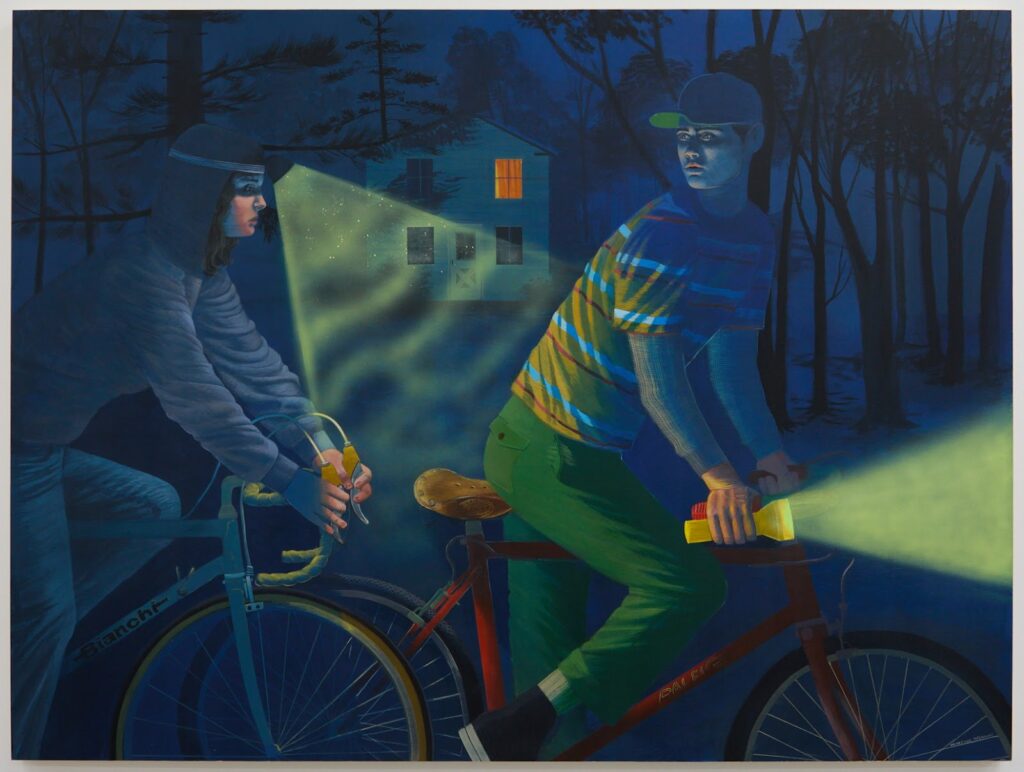Review: The Nostalgic Whimsy of Marcelle Reinecke’s In The Pines
Marcelle Reinecke’s painting show, In The Pines, on view until February 15 at Monya Rowe Gallery in Midtown Manhattan, brought me back to childhood camping trips and fishing adventures. The rustic scenery, ranch-style decor and depictions of outdoor activities blur the line between illustration and painting. A striking close-up of a wintertime hunter dragging her… Continue reading Review: The Nostalgic Whimsy of Marcelle Reinecke’s In The Pines The post Review: The Nostalgic Whimsy of Marcelle Reinecke’s In The Pines appeared first on Fair Observer.

Marcelle Reinecke’s painting show, In The Pines, on view until February 15 at Monya Rowe Gallery in Midtown Manhattan, brought me back to childhood camping trips and fishing adventures. The rustic scenery, ranch-style decor and depictions of outdoor activities blur the line between illustration and painting.
A striking close-up of a wintertime hunter dragging her kill in the snow was placed immediately at the exhibition entrance. The hunter’s bright orange vest and hat stood out against the less saturated green and blue planes in the background. This painting set the tone for the entire show, and was a solid choice to place at the entrance.
Harmony and whimsy
Reinecke’s painting style brings fine detail and simplicity into harmony. Broad areas of flat color are interrupted by linework that creates form, color and light simultaneously. You must see the show in person to truly experience this. It is impressive that she accomplished such divergent methods of mark-making so coherently. Uniting simplicity, complexity and disparate painting styles without falling into discordance is a theme throughout the show.
The whimsy of outdoor activities was on full display in nearly every painting. As was the magical feeling of nostalgia reinforced by designs, patterns and items from the 1970s. Special moments, like a child sitting in a plaid camping chair with sparks from a fire glowing around him, called to mind some of my most innocent childhood memories. These images phase into adolescence and tell a coming-of-age story as paintings of children doing childish things evolve into paintings of adolescents in more mature situations.

Hotter Than Warm. Used with permission from the artist and Monya Rowe Gallery.
One painting, the dynamic Meet in the Kitchen, was set entirely indoors. It shows the crowded interior of a ranch-style cabin with brass ducks above the fireplace to match. In the open-concept kitchen, people gathered to whisper secrets and share intimate moments. The most theatrical painting in Pines, it also teeters on the edge of disharmony (unlike the other paintings) due to an array of clashing garish patterns characteristic of the 1970s mantra, “more is more.” Yet, the painting succeeds because Reinecke leans into eclecticism and pairs electric patterns with a dynamic social scene and an almost cavernous space.

Meet In The Kitchen. Used with permission from the artist and Monya Rowe Gallery.
Some works were unrefined
The only thing lacking in Reinecke’s charming paintings was a sense of finish and refinement in small areas of several works. In two paintings, the trees in the background were not painted in the same style or with the same level of detail as the rest of her paintings. These left me wanting a little more to feel the paintings were “complete.”
A tiny area of background between two kissing lips stuck out for its white color, different from the rest of the background. Similarly, some small background figures could have benefited from more definition. This may seem nitpicky, but these small areas deserve to be brought up to the same level of resolve and quality as the result of her work so they do not distract from what Reinecke’s paintings get right.
Reinecke: master of the visual story
Let me be clear: Reinecke’s paintings get a lot right.
For instance, Offset Hook and the titular In The Pines demonstrate a superior understanding of how to make light and shadow superbly beautiful while subtle — almost translucent. Pines in particular helps to tell a story across the various paintings. It breaks from the theme of innocence with images of female nudity, creating a sense that the characters in the paintings grow and change over the years across their outdoor odysseys. The mysteriousness of The Collector’s House, featuring two children on bikes at night up to who knows what, is only accentuated by the beaming light from a headlamp as its particles wave through fog and mist. Reinecke is truly a master of the visual story.

Offset Hook. Used with permission from the artist and Monya Rowe Gallery.

In The Pines. Used with permission from the artist and Monya Rowe Gallery.

The Collector’s House. Used with permission from the artist and Monya Rowe Gallery.
In The Pines is worth the trip to Midtown. It will bring you back to your childhood trips to national parks, summer camp, fishing with dad and general mischief-making. The memories Reinecke’s paintings evoke are colored with both bright and muted hues, reminding us of when life was simple, time seemed endless and magic was behind every tree and under every rock found in a river bed.
[Lee Thompson-Kolar edited this piece.]
The views expressed in this article are the author’s own and do not necessarily reflect Fair Observer’s editorial policy.
The post Review: The Nostalgic Whimsy of Marcelle Reinecke’s In The Pines appeared first on Fair Observer.
What's Your Reaction?









































































































